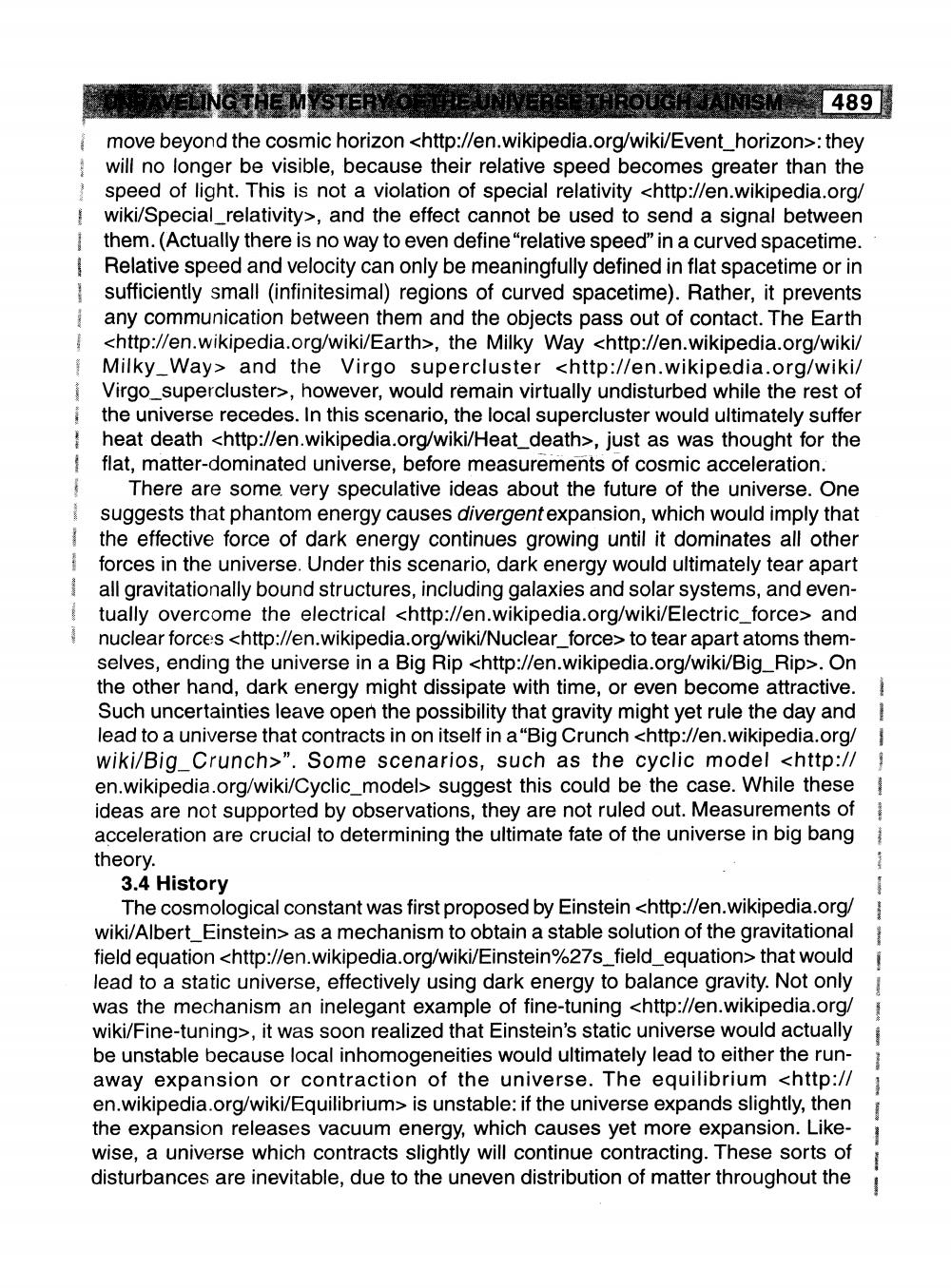________________
OSAVELING THE MYSTERY OF THE UNIVERSE THROUGH JAINISM 489
move beyond the cosmic horizon <http://en.wikipedia.org/wiki/Event_horizon>: they will no longer be visible, because their relative speed becomes greater than the speed of light. This is not a violation of special relativity <http://en.wikipedia.org/ !wiki/Special_relativity>, and the effect cannot be used to send a signal between them. (Actually there is no way to even define "relative speed" in a curved spacetime. Relative speed and velocity can only be meaningfully defined in flat spacetime or in I sufficiently small (infinitesimal) regions of curved spacetime). Rather, it prevents any communication between them and the objects pass out of contact. The Earth <http://en.wikipedia.org/wiki/Earth>, the Milky Way <http://en.wikipedia.org/wiki/ Milky Way> and the Virgo supercluster <http://en.wikipedia.org/wiki/ | Virgo supercluster>, however, would remain virtually undisturbed while the rest of the universe recedes. In this scenario, the local supercluster would ultimately suffer heat death <http://en.wikipedia.org/wiki/Heat_death>, just as was thought for the 1 flat, matter-dominated universe, before measurements of cosmic acceleration.
There are some very speculative ideas about the future of the universe. One suggests that phantom energy causes divergent expansion, which would imply that the effective force of dark energy continues growing until it dominates all other forces in the universe. Under this scenario, dark energy would ultimately tear apart I all gravitationally bound structures, including galaxies and solar systems, and evenItually overcome the electrical <http://en.wikipedia.org/wiki/Electric_force> and
nuclear forces <http://en.wikipedia.org/wiki/Nuclear_force> to tear apart atoms themselves, ending the universe in a Big Rip <http://en.wikipedia.org/wiki/Big_Rip>. On the other hand, dark energy might dissipate with time, or even become attractive. Such uncertainties leave open the possibility that gravity might yet rule the day and I lead to a universe that contracts in on itself in a "Big Crunch <http://en.wikipedia.org/ | wiki/Big Crunch>". Some scenarios, such as the cyclic model <http://} en.wikipedia.org/wiki/Cyclic_model> suggest this could be the case. While these 1 ideas are not supported by observations, they are not ruled out. Measurements of acceleration are crucial to determining the ultimate fate of the universe in big bang 1 theory.
3.4 History
The cosmological constant was first proposed by Einstein <http://en.wikipedia.org/ wiki/Albert Einstein> as a mechanism to obtain a stable solution of the gravitational field equation <http://en.wikipedia.org/wiki/Einstein%27s_field_equation> that would lead to a static universe, effectively using dark energy to balance gravity. Not only was the mechanism an inelegant example of fine-tuning <http://en.wikipedia.org/ wiki/Fine-tuning>, it was soon realized that Einstein's static universe would actually be unstable because local inhomogeneities would ultimately lead to either the runaway expansion or contraction of the universe. The equilibrium <http:// en.wikipedia.org/wiki/Equilibrium> is unstable: if the universe expands slightly, then the expansion releases vacuum energy, which causes yet more expansion. Likewise, a universe which contracts slightly will continue contracting. These sorts of disturbances are inevitable, due to the uneven distribution of matter throughout the




